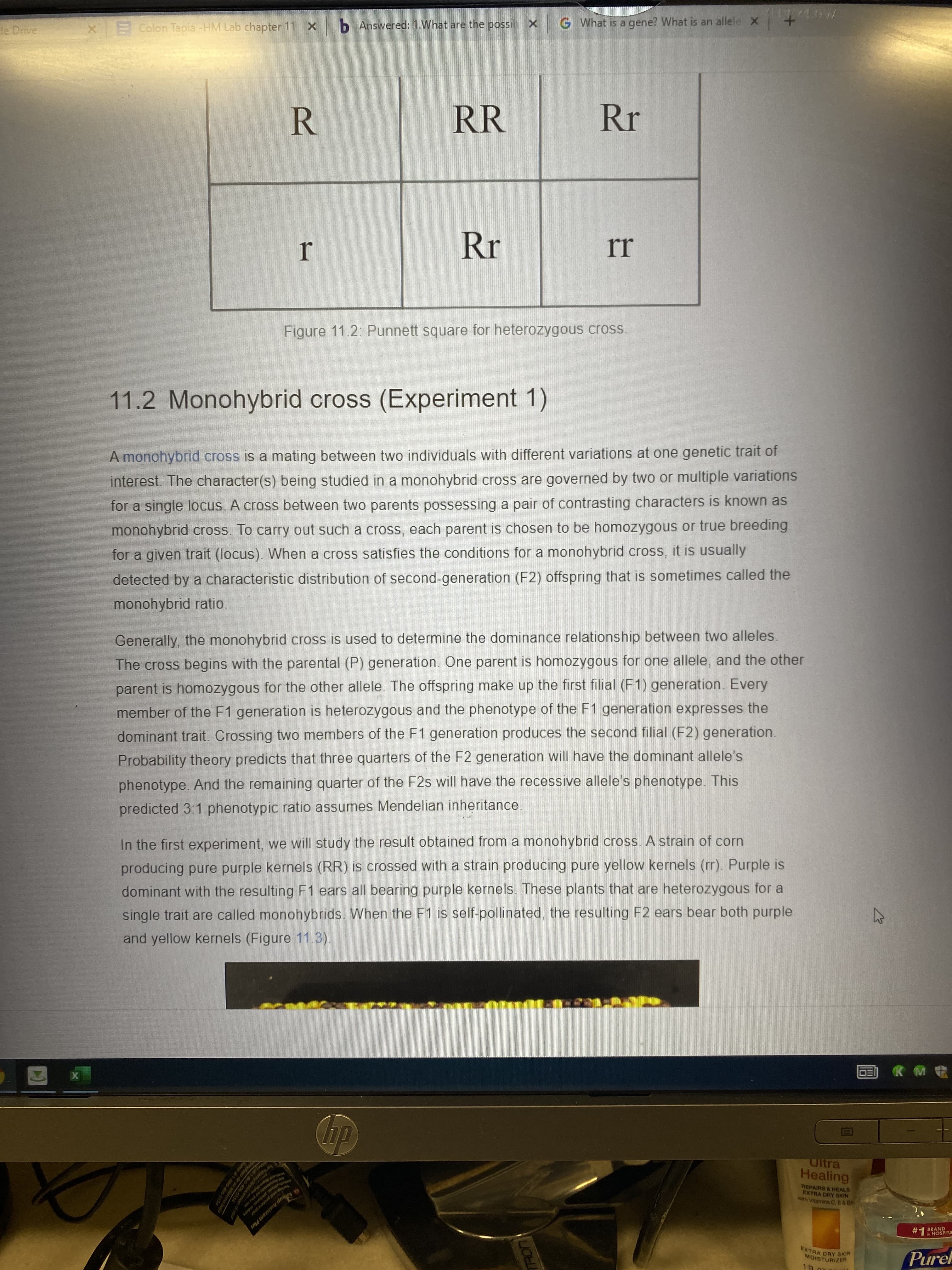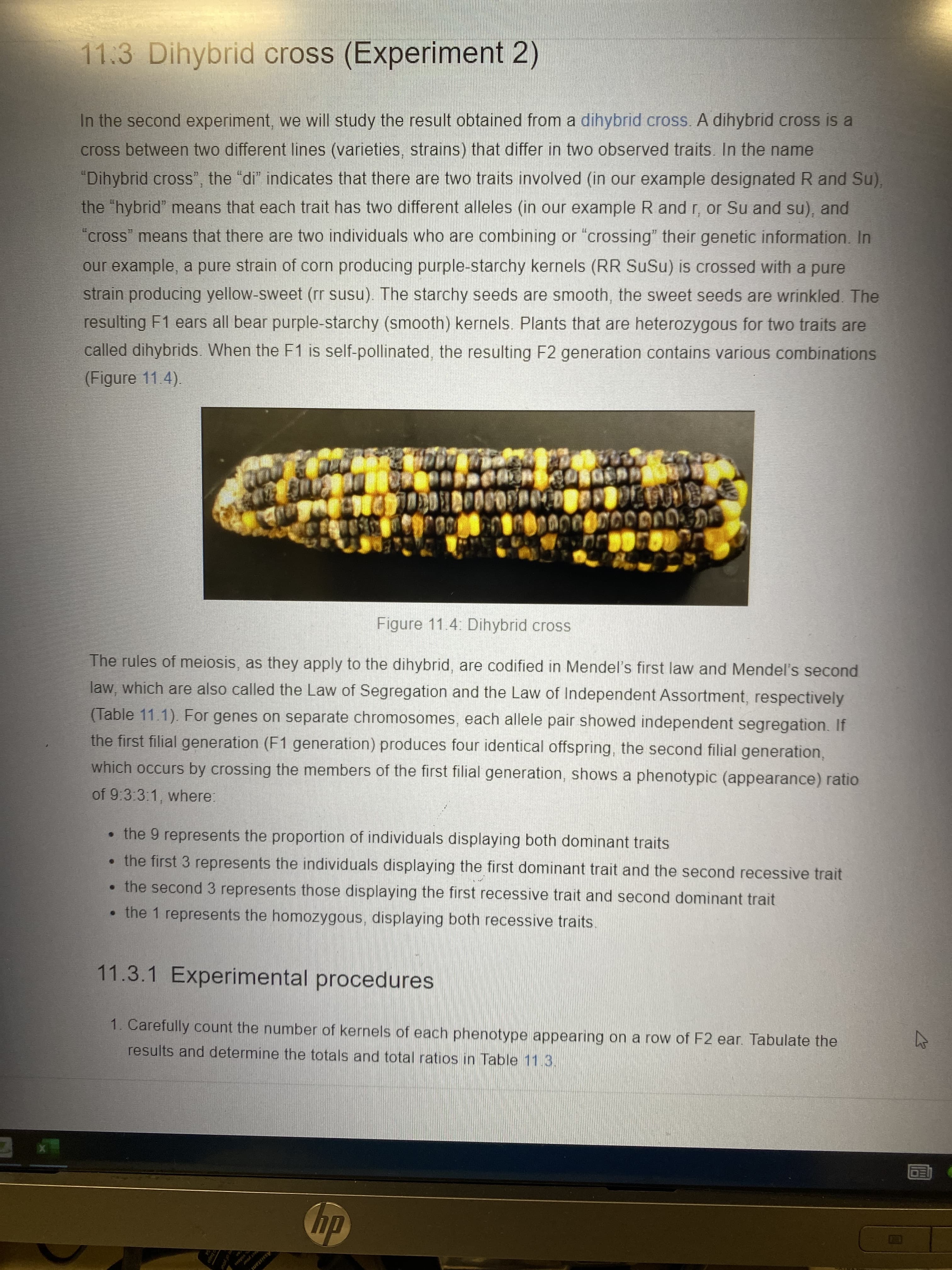What is the genotype of the F1 generation of the corn monohybrid cross described above? What is the phenotype of the F1 generation of the corn monohybrid cross described above? What are the possible maternal and paternal genotypes of the F1 gametes of the corn monohybrid cross described above?
What is the genotype of the F1 generation of the corn monohybrid cross described above? What is the phenotype of the F1 generation of the corn monohybrid cross described above? What are the possible maternal and paternal genotypes of the F1 gametes of the corn monohybrid cross described above?
Biology: The Unity and Diversity of Life (MindTap Course List)
15th Edition
ISBN:9781337408332
Author:Cecie Starr, Ralph Taggart, Christine Evers, Lisa Starr
Publisher:Cecie Starr, Ralph Taggart, Christine Evers, Lisa Starr
Chapter13: Observing Patterns In Inherited Traits
Section: Chapter Questions
Problem 2DAA
Related questions
Topic Video
Question
- What is the genotype of the F1 generation of the corn monohybrid cross described above?
- What is the phenotype of the F1 generation of the corn monohybrid cross described above?
- What are the possible maternal and paternal genotypes of the F1 gametes of the corn monohybrid cross described above?
- What is the genotype of the parents of the corn dihybrid cross described above?
- What are the
phenotypes of the parents of the corn dihybrid cross described above? - What are the possible genotypes of the parent gametes of the corn dihybrid cross described above?
- What is the genotype of the F1 generation of the corn dihybrid cross described above?
- What is the phenotype of the F1 generation of the corn dihybrid cross described above?
- What are the possible maternal and paternal genotypes of the F1 gametes of the corn dihybrid cross described above?

Transcribed Image Text:lacement of gou
o de su tefono bajo
me al1 6465154
usic, pictates, videps
d hare them a
G What is a gene? What is an allele x + /
X Colon Tapia -HM Lab chapter 11 X b Answered: 1.What are the possib x
de Drive
RR
Rr
R.
Rr
rr
Figure 11.2: Punnett square for heterozygous cross.
11.2 Monohybrid cross (Experiment 1)
A monohybrid cross is a mating between two individuals with different variations at one genetic trait of
interest. The character(s) being studied in a monohybrid cross are governed by two or multiple variations
for a single locus. A cross between two parents possessing a pair of contrasting characters is known as
monohybrid cross. To carry out such a cross, each parent is chosen to be homozygous or true breeding
for a given trait (locus). When a cross satisfies the conditions for a monohybrid cross, it is usually
detected by a characteristic distribution of second-generation (F2) offspring that is sometimes called the
monohybrid ratio.
The cross begins with the parental (P) generation. One parent is homozygous for one allele, and the other
parent is homozygous for the other allele. The offspring make up the first filial (F1) generation. Every
member of the F1 generation is heterozygous and the phenotype of the F1 generation expresses the
Generally, the monohybrid cross is used to determine the dominance relationship between two alleles.
dominant trait. Crossing two members of the F1 generation produces the second filial (F2) generation.
Probability theory predicts that three quarters of the F2 generation will have the dominant allele's
phenotype. And the remaining quarter of the F2s will have the recessive allele's phenotype. This
predicted 3:1 phenotypic ratio assumes Mendelian inheritance.
In the first experiment, we will study the result obtained from a monohybrid cross. A strain of corn
producing pure purple kernels (RR) is crossed with a strain producing pure yellow kernels (rr). Purple is
dominant with the resulting F1 ears all bearing purple kernels. These plants that are heterozygous for a
single trait are called monohybrids. When the F1 is self-pollinated, the resulting F2 ears bear both purple
and yellow kernels (Figure 11.3).
ER M
Oltra
Healing
REPAIRS & HEALS
EXTRA DRY SKIN
with Vitamine C, E&B6
BRAND
in HOSPITA
menss so yor
S od erotect your
up Assistant Plus
EXTRA DRY SKIN
MOISTURIZER
Purel

Transcribed Image Text:videns
11.3 Dihybrid cross (Experiment 2)
In the second experiment, we will study the result obtained from a dihybrid cross. A dihybrid cross is a
cross between two different lines (varieties, strains) that differ in two observed traits. In the name
"Dihybrid cross', the "di" indicates that there are two traits involved (in our example designated R and Su),
the "hybrid" means that each trait has two different alleles (in our example R and r, or Su and su), and
cross" means that there are two individuals who are combining or "crossing" their genetic information. In
our example, a pure strain of corn producing purple-starchy kernels (RR SuSu) is crossed with a pure
strain producing yellow-sweet (rr susu). The starchy seeds are smooth, the sweet seeds are wrinkled. The
resulting F1 ears all bear purple-starchy (smooth) kernels. Plants that are heterozygous for two traits are
called dihybrids. When the F1 is self-pollinated, the resulting F2 generation contains various combinations
(Figure 11.4).
Figure 11.4: Dihybrid cross
The rules of meiosis, as they apply to the dihybrid, are codified in Mendel's first law and Mendel's second
law, which are also called the Law of Segregation and the Law of Independent Assortment, respectively
(Table 11.1). For genes on separate chromosomes, each allele pair showed independent segregation. If
the first filial generation (F1 generation) produces four identical offspring, the second filial generation,
which occurs by crossing the members of the first filial generation, shows a phenotypic (appearance) ratio
of 9:3:3:1, where:
• the 9 represents the proportion of individuals displaying both dominant traits
• the first 3 represents the individuals displaying the first dominant trait and the second recessive trait
•the second 3 represents those displaying the first recessive trait and second dominant trait
• the 1 represents the homozygous, displaying both recessive traits.
11.3.1 Experimental procedures
1. Carefully count the number of kernels of each phenotype appearing on a row of F2 ear. Tabulate the
results and determine the totals and total ratios in Table 11.3.
dp
ect your
Assistant
Expert Solution
This question has been solved!
Explore an expertly crafted, step-by-step solution for a thorough understanding of key concepts.
This is a popular solution!
Trending now
This is a popular solution!
Step by step
Solved in 2 steps

Knowledge Booster
Learn more about
Need a deep-dive on the concept behind this application? Look no further. Learn more about this topic, biology and related others by exploring similar questions and additional content below.Recommended textbooks for you

Biology: The Unity and Diversity of Life (MindTap…
Biology
ISBN:
9781337408332
Author:
Cecie Starr, Ralph Taggart, Christine Evers, Lisa Starr
Publisher:
Cengage Learning

Biology: The Unity and Diversity of Life (MindTap…
Biology
ISBN:
9781305073951
Author:
Cecie Starr, Ralph Taggart, Christine Evers, Lisa Starr
Publisher:
Cengage Learning

Human Heredity: Principles and Issues (MindTap Co…
Biology
ISBN:
9781305251052
Author:
Michael Cummings
Publisher:
Cengage Learning

Biology: The Unity and Diversity of Life (MindTap…
Biology
ISBN:
9781337408332
Author:
Cecie Starr, Ralph Taggart, Christine Evers, Lisa Starr
Publisher:
Cengage Learning

Biology: The Unity and Diversity of Life (MindTap…
Biology
ISBN:
9781305073951
Author:
Cecie Starr, Ralph Taggart, Christine Evers, Lisa Starr
Publisher:
Cengage Learning

Human Heredity: Principles and Issues (MindTap Co…
Biology
ISBN:
9781305251052
Author:
Michael Cummings
Publisher:
Cengage Learning


Anatomy & Physiology
Biology
ISBN:
9781938168130
Author:
Kelly A. Young, James A. Wise, Peter DeSaix, Dean H. Kruse, Brandon Poe, Eddie Johnson, Jody E. Johnson, Oksana Korol, J. Gordon Betts, Mark Womble
Publisher:
OpenStax College
